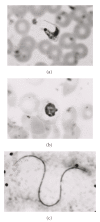Diagnosis of parasitic diseases: old and new approaches
- PMID: 20069111
- PMCID: PMC2804041
- DOI: 10.1155/2009/278246
Diagnosis of parasitic diseases: old and new approaches
Abstract
Methods for the diagnosis of infectious diseases have stagnated in the last 20-30 years. Few major advances in clinical diagnostic testing have been made since the introduction of PCR, although new technologies are being investigated. Many tests that form the backbone of the "modern" microbiology laboratory are based on very old and labour-intensive technologies such as microscopy for malaria. Pressing needs include more rapid tests without sacrificing sensitivity, value-added tests, and point-of-care tests for both high- and low-resource settings. In recent years, research has been focused on alternative methods to improve the diagnosis of parasitic diseases. These include immunoassays, molecular-based approaches, and proteomics using mass spectrometry platforms technology. This review summarizes the progress in new approaches in parasite diagnosis and discusses some of the merits and disadvantages of these tests.
Figures



Similar articles
-
A review on point of care tests in parasitology.Indian J Med Microbiol. 2022 Jul-Sep;40(3):337-341. doi: 10.1016/j.ijmmb.2022.02.003. Epub 2022 Mar 3. Indian J Med Microbiol. 2022. PMID: 35248402 Review.
-
Rapid diagnosis of parasitic diseases: current scenario and future needs.Clin Microbiol Infect. 2019 Mar;25(3):290-309. doi: 10.1016/j.cmi.2018.04.028. Epub 2018 May 3. Clin Microbiol Infect. 2019. PMID: 29730224 Review.
-
Diagnosis of parasitic infections: what's going on?J Biomol Screen. 2015 Jan;20(1):6-21. doi: 10.1177/1087057114548065. Epub 2014 Aug 28. J Biomol Screen. 2015. PMID: 25170017 Review.
-
Sensing parasites: Proteomic and advanced bio-detection alternatives.J Proteomics. 2016 Mar 16;136:145-56. doi: 10.1016/j.jprot.2015.12.030. Epub 2016 Jan 7. J Proteomics. 2016. PMID: 26773860 Review.
-
Recent Progress in the Development of Diagnostic Tests for Malaria.Diagnostics (Basel). 2017 Sep 19;7(3):54. doi: 10.3390/diagnostics7030054. Diagnostics (Basel). 2017. PMID: 28925968 Free PMC article. Review.
Cited by
-
Development of an in vitro drug screening assay using Schistosoma haematobium schistosomula.Parasit Vectors. 2012 Aug 9;5:165. doi: 10.1186/1756-3305-5-165. Parasit Vectors. 2012. PMID: 22876861 Free PMC article.
-
State-of-the-Art Techniques for Diagnosis of Medical Parasites and Arthropods.Diagnostics (Basel). 2021 Aug 26;11(9):1545. doi: 10.3390/diagnostics11091545. Diagnostics (Basel). 2021. PMID: 34573887 Free PMC article. Review.
-
Molecular and Functional Characterization of ssDNA Aptamers that Specifically Bind Leishmania infantum PABP.PLoS One. 2015 Oct 12;10(10):e0140048. doi: 10.1371/journal.pone.0140048. eCollection 2015. PLoS One. 2015. PMID: 26457419 Free PMC article.
-
Leucocytozoon caulleryi discovery utilizing indirect-ELISA in East Java, Indonesia as a new approach in detecting leucocytozoonosis.Open Vet J. 2025 Apr;15(4):1557-1564. doi: 10.5455/OVJ.2025.v15.i4.6. Epub 2025 Apr 30. Open Vet J. 2025. PMID: 40453850 Free PMC article.
-
Effective Laboratory Diagnosis of Parasitic Infections of the Gastrointestinal Tract: Where, When, How, and What Should We Look For?Diagnostics (Basel). 2024 Sep 27;14(19):2148. doi: 10.3390/diagnostics14192148. Diagnostics (Basel). 2024. PMID: 39410552 Free PMC article. Review.
References
-
- Hancock K, Tsang VCW. Development and optimization of the FAST-ELISA for detecting antibodies to Schistosoma mansoni. Journal of Immunological Methods. 1986;92(2):167–176. - PubMed
-
- Pappas MG, Hajkowski R, Hockmeyer WT. Dot enzyme-linked immunosorbent assay (Dot-ELISA): a micro technique for the rapid diagnosis of visceral leishmaniasis. Journal of Immunological Methods. 1983;64(1-2):205–214. - PubMed
-
- Pappas MG. Recent applications of the Dot-ELISA in immunoparasitology. Veterinary Parasitology. 1988;29(2-3):105–129. - PubMed
LinkOut - more resources
Full Text Sources
Other Literature Sources
